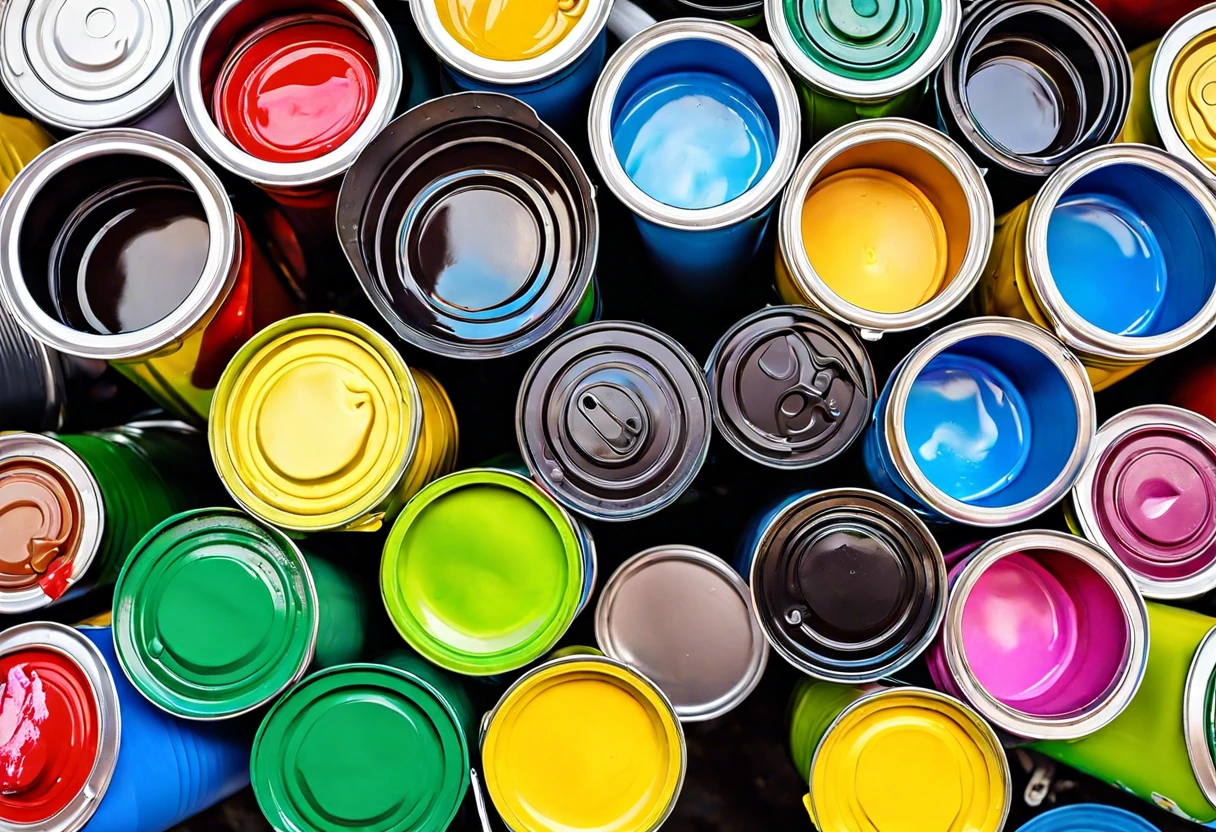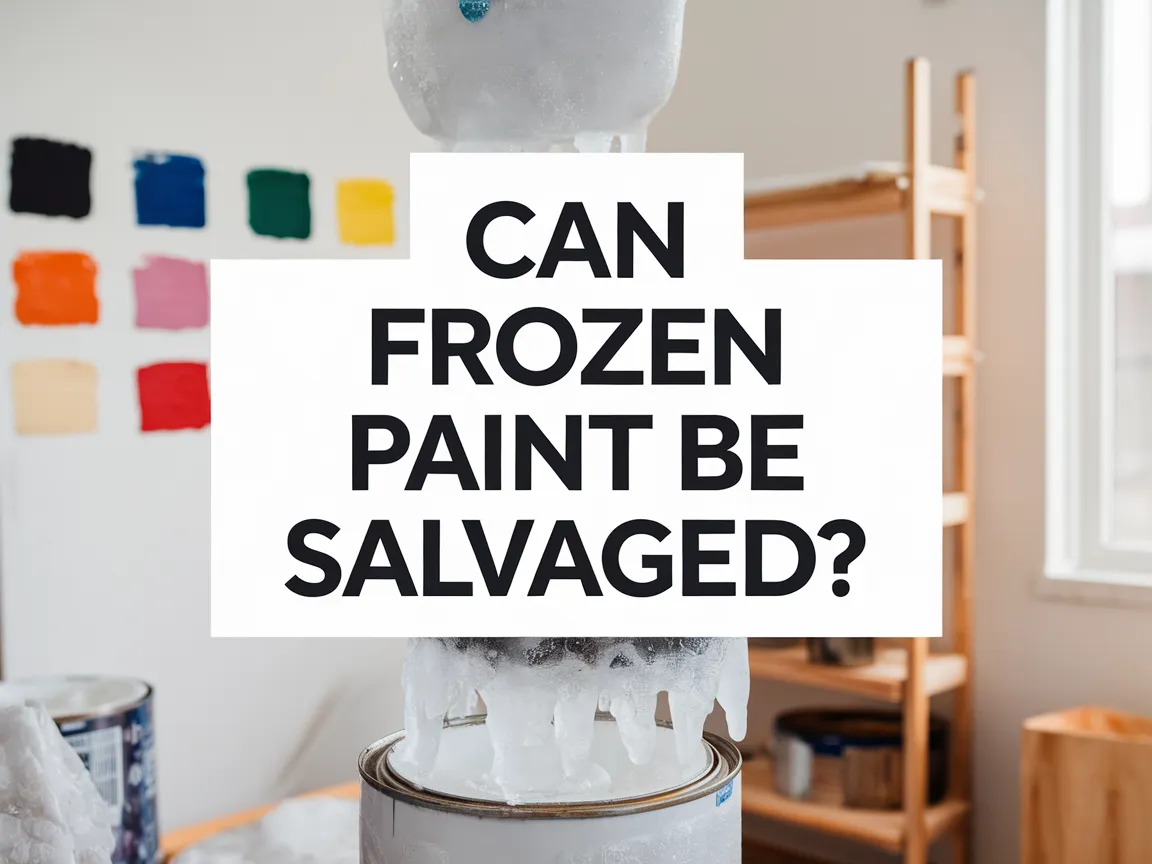Can You Put Paint Cans in the Bin?
Published on: January 31, 2025 | Last Updated: January 7, 2025
Written By: Sarah McClintock
Paint cans are containers that store wet paint. They keep the colorful goo safe until you’re ready to create your masterpiece!
When asking can you put paint cans in the bin, it’s super important to know what to do first. I’ve learned the hard way that proper disposal keeps our environment clean and safe.
In this guide, you’ll discover what paint cans are, what to consider before disposal, learn steps for proper disposal, explore recommended color palettes, identify types of paint cans, and tackle common disposal issues, plus DIY ideas using leftover paint cans.
Contents
- 1 Can You Put Paint Cans in the Bin?
- 2 What Are Paint Cans?
- 3 What You Need to Know Before Disposing Of Paint Cans
- 4 Steps to Properly Dispose Of Paint Cans
- 5 Types Of Paint Cans and Their Disposal Requirements
- 6 Factors Affecting the Disposal Of Paint Cans
- 7 Common Issues When Disposing Of Paint Cans
- 8 Environmental Impact of Improper Disposal
- 9 How to Find Your Local Paint Disposal Guidelines
- 10 Paint Can Recycling Programs
- 11 Hazardous Waste Disposal Facilities
- 12 Paint Cans and Their Impact on Community Recycling
- 13 Reusing Paint Cans: Creative Options
- 14 Finishing Touches: Ensuring Safe Disposal
- 15 FAQ
- 16 Conclusion
- 17 Additional Resources
Can You Put Paint Cans in the Bin?
No, you can’t toss paint cans in the regular bin. Full or partially full cans are hazardous waste. Most places require you to dispose of them at a hazardous waste facility. Check your local guidelines for safe disposal options. If you’re looking to refresh your space, you might want to transform your bathroom vanity with paint.
The Finishing Touch
A freshly painted wall is a blank canvas. The best way to bring your room to life is with a single piece of statement art that ties everything together.
Browse Wall Art at Big Wall DecorWhat Are Paint Cans?
Paint cans are containers designed for storing paints and coatings. Usually made from steel or aluminum, they come in various sizes, commonly 1 quart (0.946 Liters), 1 gallon (3.785 Liters), and larger capacities for industrial use. If you’re exploring creative painting project ideas, you might want to consider different techniques for decorating pumpkins.
When it comes to paint cans, an important question arises: can you put them in the bin? I remember facing a dilemma while cleaning my garage. I had a few old paint cans lying around, and deciding what to do with them was quite a task. If you’re wondering about painting alternatives for your space, you might want to explore transforming bathroom tile walls.
I used paint cans for a large project at home. It opened my eyes to safely handling them. For leftover paint, it’s crucial not to just toss the cans away. If you want to know how to dry up paint effectively or how to properly dispose of old paint, handling these responsibilities is key to avoiding hazards and waste. When working with different paint types, you might wonder about specific material applications like painting techniques for metal surfaces.
What You Need to Know Before Disposing Of Paint Cans
What do you need to get started?
- Five-Gallon Bucket: You’ll need a bucket, like the Home Depot 5-Gallon Bucket, to collect leftover paint and residue.
- Gloves: Wear chemical-resistant gloves, such as Jackson Safety G60 Green Nitrile Disposable Gloves. They protect your hands while handling paint.
- Paint Can Lid Remover: A tool like the Dewalt DCS391B Circular Saw can open stubborn lids, helping you access the contents safely.
- Plastic Drop Cloth: Use a drop cloth, like AmazonBasics 9′ x 12′. It’s important for protecting surfaces when pouring out paint.
That covers essential information on paint can disposal. Let’s now take a look at the proper disposal steps.
Also See: How Do You Dispose Of Paint Cans? Quick Eco Tips
The Finishing Touch
A freshly painted wall is a blank canvas. The best way to bring your room to life is with a single piece of statement art that ties everything together.
Browse Wall Art at Big Wall Decor
Steps to Properly Dispose Of Paint Cans
Here are the steps to safely handle paint cans for disposal.
-
Evaluate the Paint Can’s Contents
Check for leftover paint. If the can’s half full or more, it’s hazardous waste and requires special handling.
Solidify the remaining paint by adding cat litter or sawdust. Let it dry for several hours before proceeding.
-
Find Local Disposal Regulations
Research your county’s regulations for paint disposal. Some areas have specific drop-off sites for hazardous materials.
Visit local waste management websites for details, including dates and locations for safe disposal events.
-
Prepare the Paint Can for Disposal
Remove the lid from the paint can once it’s solidified. This ensures the contents aren’t flammable, making transport safer.
Always label the exterior with a permanent marker as “empty” or “dry paint” to avoid confusion during collection.
-
Choose the Right Disposal Method
Take the paint can to a designated hazardous waste facility or note your town’s next clean-up day. Not all areas allow you to throw out paint cans in regular trash.
If you can’t find the right place, contact a waste disposal expert. Local resource numbers can provide guidance.
We’ve wrapped up the steps for disposing of paint cans here. Let us turn our attention to types of paint cans and their disposal requirements.
Types Of Paint Cans and Their Disposal Requirements
Let’s discuss the types of paint cans: metal cans, plastic cans, aerosol cans, and multipurpose containers.
-
Metal Cans
Metal cans hold 0.95 L to 18.93 L (1 Quart to 5 Gallons) of paint. Don’t just toss these in the bin—check local disposal rules.
-
Plastic Cans
Plastic cans usually come in smaller sizes, such as 0.94 L (1 Quart) or 3.79 L (1 Gallon). Look for recycling options; they usually can’t go in regular trash.
-
Aerosol Cans
Aerosol cans may contain paint or spray products and have different disposal rules. Always empty these cans and check local guidelines for recycling or special handling.
-
Multipurpose Containers
Multipurpose containers hold various media beyond paint, often for crafts. These cans can often be reused, but check for contamination before disposal.
From my experience, metal cans require careful handling. Due to their size, disposal rules can be strict but are essential for environmental safety.
We have now covered the different types of paint cans and how to dispose of them. Next, we will examine disposal factors.
Factors Affecting the Disposal Of Paint Cans
What factors determine if you can toss those paint cans in the bin?
-
Type of Paint: Water-based paints are safer for regular trash, while oil-based paints need special disposal.
-
Local Regulations: Some areas have strict rules on hazardous waste, affecting how you dispose of paint.
-
Cure Time: Fully dried paint cans are safer to dispose of with regular trash than wet ones.
-
Container Condition: Rusty or leaking cans can be hazardous and typically require special disposal methods.
We covered elements influencing paint can disposal. We will now cover typical challenges encountered during the disposal process.

Common Issues When Disposing Of Paint Cans
My friend once tossed a nearly empty paint can in the bin without thinking. Trouble started when the lid rusted, leaking paint everywhere!
To avoid this, always dry up leftover paint with sawdust or cat litter. Aim for less than 0.5 liters (17 Ounces) per can. Dispose of fully dried paint cans with regular trash.
Environmental Impact of Improper Disposal
Understanding the environmental impact of paint can disposal is essential.
-
Soil Contamination
Paint cans can leak harmful chemicals into the soil. This pollution affects plant growth and enters the food chain.
-
Water Pollution
If paint makes its way into water systems, it can poison aquatic life. Even small amounts can upset local ecosystems!
-
Air Quality
Some paints release volatile organic compounds (VOCs) into the air. These contribute to smog and can affect respiratory health.
How to Find Your Local Paint Disposal Guidelines
Wondering how to find your local disposal guidelines? It’s simpler than you think!
| Region | Resource | Contact Information |
|---|---|---|
| California | CalRecycle | Visit Site |
| Texas | Texas Commission on Environmental Quality | Visit Site |
| New York | New York State Department of Environmental Conservation | Visit Site |
| Florida | Florida Department of Environmental Protection | Visit Site |
The Finishing Touch
A freshly painted wall is a blank canvas. The best way to bring your room to life is with a single piece of statement art that ties everything together.
Browse Wall Art at Big Wall Decor
Paint Can Recycling Programs
Wondering if you can recycle those empty paint cans? There are programs dedicated to making this easy.
- Local Recycling Centers: Check if your local recycling center accepts empty paint cans.
- Specialized Events: Many communities host recycling events where you can drop off paint cans.
- Manufacturer Take-Back Programs: Some paint brands offer programs to reclaim old cans for recycling.
Hazardous Waste Disposal Facilities
Each state often has designated facilities to handle hazardous waste. Here’s a closer look:
| State | Facility Type | Website/Contact |
|---|---|---|
| California | Treatment & Disposal | Visit CalRecycle |
| New York | Community Collection Centers | Visit DEC |
| Texas | Recycling Facilities | Visit TCEQ |
| Florida | Hazardous Waste Sites | Visit DEP |
Paint Cans and Their Impact on Community Recycling
Paint cans can significantly affect local recycling efforts. Here’s what you should know:
- Contamination Risks: If disposed of improperly, paint cans can contaminate recyclable materials.
- Community Awareness: Educating locals on safe disposal helps improve recycling rates.
- Effective Programs: Local governments often implement programs aimed at reducing hazardous waste through better disposal options.
Reusing Paint Cans: Creative Options
Let’s chat about reusing that empty paint can! There’s more than one way to get creative!
-
Garden Decor
Transform your paint cans into quirky garden decor. Paint them bright colors, fill with soil, and plant herbs or flowers!
-
Craft Storage
Use them to store art supplies or as unique home storage solutions. Decorate them to match your personal style!
-
Party Lanterns
Create lanterns! Punch holes in the can, add a candle inside, and hang them for a cozy evening glow.
Finishing Touches: Ensuring Safe Disposal
After you’ve assessed disposal options, let opened paint cans sit for 24 hours to dry. Remove or secure labels to avoid confusion during recycling.
Inspect the cans for rust or leaks. Use unopened products like Rust-Oleum® to reduce waste—sealed cans can last for years if stored correctly.
If you have experience, consider using a vacuum pump to remove air from partially filled cans. Store them upright at a temperature of 10°C-25°C (50°F-77°F) to prevent degradation.
Also See: Can You Paint Your Rims Black? Here’s What to Know!
FAQ
Can I Throw Empty Paint Cans in the Regular Trash?
Yes, you can throw empty paint cans in the regular trash. Empty paint cans have little to no residue left, making them non-hazardous according to many local waste management rules.
What Should I Do With Leftover Paint?
You should store leftover paint properly. Ideally, keep it in a cool, dry place and ensure the lid is tightly sealed to prevent drying out.
Are Oil-based Paint Cans Treated Differently?
Yes, oil-based paint cans are treated differently. They often contain hazardous materials and may require special disposal methods to ensure environmental safety.
Can I Recycle Paint Cans?
Yes, you can recycle paint cans, but only if they are empty and clean. Most curbside recycling programs accept them, ensuring valuable materials are reused.
What Happens if I Dispose Of Paint Cans Incorrectly?
If you dispose of paint cans incorrectly, it can lead to environmental pollution. Toxic chemicals might seep into soil or water, causing health risks.
How Can I Properly Dispose Of Hazardous Paint Products?
You can properly dispose of hazardous paint products by taking them to a local hazardous waste facility. Such facilities are equipped to handle these materials safely.
What is the Best Way to Dry Up Leftover Paint?
The best way to dry up leftover paint is using absorbent materials like cat litter or shredded newspaper. This method makes disposal easier, keeping your space tidy.
Conclusion
We covered what paint cans are, the considerations for disposal, the proper disposal steps, the various types of paint cans and their requirements, factors affecting disposal, common issues, and DIY project ideas using leftover paint cans.
I hope this guide has clarified the question: can you put paint cans in the paint disposal guidelines? In summary, it depends on whether the cans are empty or still contain paint; always consult local regulations for safe disposal methods.
For more information, visit Paint Answers, where you’ll find valuable techniques, tips, and best practices.
Additional Resources
- Smith, R. (2003). The Artist’s Handbook of Materials and Techniques (5th ed.). New York, NY: Knopf.
- How to Dispose of Paint Properly | Angi
- How to Store and Dispose of Paint | Lowe’s









